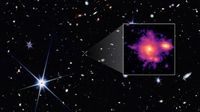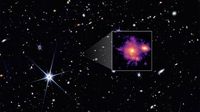On April 17, 2025, the James Webb Space Telescope made groundbreaking discoveries that could reshape our understanding of the universe. Two significant findings were announced: the possible detection of extraterrestrial life and the discovery of the most distant galaxy akin to the Milky Way, named Zhulong, meaning 'Fakelny Dragon' in Chinese.
A team of astronomers from Cambridge, UK, has made strides towards unraveling one of the greatest mysteries of the cosmos—the existence of life beyond Earth. Utilizing the advanced capabilities of the James Webb telescope, they identified organic compounds in the atmosphere of an exoplanet known as K2-18b, located over 120 light-years away. The substances detected include dimethyl sulfide (DMS) and dimethyl disulfide (DMDS), both of which on Earth are associated exclusively with living organisms, particularly marine microorganisms.
This discovery marks a significant milestone as such compounds have never been found beyond our planet before. K2-18b, which resides in the constellation Leo, is notably larger and heavier than Earth, being 2.6 times its size and nearly nine times its mass. It orbits within the "habitable zone" of its star, where conditions could allow for liquid water—a key ingredient for life as we know it.
Previously, the atmosphere of K2-18b had shown the presence of carbon dioxide and methane, and modeling studies suggest the existence of a global ocean and a hydrogen atmosphere. The analysis of the DMS and DMDS signals indicated a confidence level of three sigmas, meaning there is only about a 0.3% chance that the findings are coincidental. However, to confirm the discovery as a significant finding, scientists need to reach a threshold of five sigmas, which corresponds to a mere 0.00006% chance of error. Achieving this will require an additional 16 to 24 hours of observations with the telescope.
Professor Nikku Madhusudhan, the head of the study, remarked, "We still have to exclude all possible non-biological scenarios. But if confirmation is received, it will become a historic moment." This cautious optimism reflects the scientific community's desire for rigorous validation before declaring the presence of extraterrestrial life.
On the same day, the James Webb Space Telescope also unveiled a remarkable find in the form of a distant galaxy named Zhulong. This galaxy is strikingly similar to the Milky Way in shape, size, and stellar mass. Previously, it was believed that galaxies like ours took billions of years to develop distinct features such as spiral arms and active star formation regions. However, Zhulong displays these ordered structures despite its light having traveled 12.8 billion years to reach us, indicating it existed only a billion years after the Big Bang.
The size of the Zhulong disk is approximately 60,000 light-years, with a stellar mass estimated at 100 billion solar masses. In comparison, the Milky Way's disk is slightly larger at 100,000 light-years, with a stellar mass of around 46 billion solar masses. The discovery of such a mature galaxy at an early stage in the universe challenges existing theories of galaxy formation and highlights the effectiveness of the James Webb programs in identifying rare and distant objects.
Future studies of Zhulong are planned, utilizing both the James Webb and the ALMA radio telescope in Chile. These investigations aim to uncover the formation history of this galaxy and provide insights into how such a structured spiral galaxy could have emerged in the early universe.
As scientists continue to analyze these findings, the implications could be profound. The potential for life beyond Earth and the unexpected maturity of early galaxies both suggest that our understanding of the universe is far from complete. Each discovery opens new avenues for research and inspires curiosity about our cosmic neighborhood.
In summary, the discoveries made by the James Webb Space Telescope on April 17, 2025, serve as a reminder of the vastness of the universe and the mysteries it still holds. As researchers delve deeper into these findings, the quest to understand life beyond our planet and the formation of galaxies continues to captivate both scientists and the public alike.


